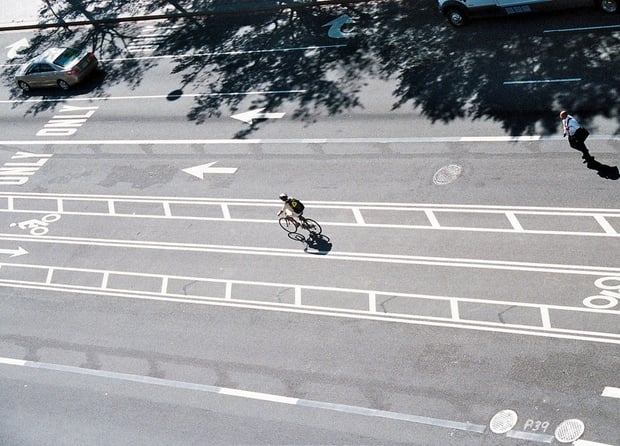When bike commuter Amanda Woerman was hit by a taxicab’s car door, she didn’t get raging mad. After all, the passenger and driver got out of the car to make sure Woerman wasn’t hurt.
The second time she got hit, however, by a minivan driver, she watched angrily as it drove off; the driver probably didn’t even realize she grazed Woerman while making a right turn.
Woerman isn’t the only avid biker—or pedestrian, for that matter—who has had run-ins with drivers in Washington. And the recent death of an 80-year-old woman who was struck by a cyclist on the Four-Mile Run in Arlington has struck a nerve with the already contentious biking community in Washington.
“I’ve never been in a collision with either [a driver or pedestrian], and I really consider myself lucky,” says Brian McEntee, who blogs his daily bike commute at Tale from the Sharrows. “Sometimes [collisions] happen because of what the driver, cyclist, and pedestrian are all doing. But the trickiest thing is that people tend to not expect bicyclists.”
From car doors opening and hitting cyclists to cyclists riding on sidewalks to drivers failing to notice the cyclist next to them in their rush to make it home, the question these days is: How truly bike-friendly is DC?
According to rankings, very. In the just the past few years, the District has steadily become one of the top-ranked bike-friendly cities in the US. The People Powered Movement, a walking and biking alliance based in DC, reports that the city’s rate of bicycle commuters has more than doubled in the past ten years, making it the seventh most popular city in the country for bike commuting. Bicycling magazine recently ranked DC as the fourth most bike-friendly city, behind Portland, Oregon; Minneapolis, Minnesota; and Boulder, Colorado, respectively.
The most frequently cited reason for DC’s growing bike community is the launch of Capital Bikeshare, the bike-sharing program that launched in May 2010 and now boasts 5,212 rides per day and more than 165 bike stations in DC and Northern Virginia. “Everybody using the Capital Bikeshare program really brings visibility to biking in the area and makes it more accessible to people who normally wouldn’t have access to a bike,” says Brighid O’Keane, Alliance for Biking & Walking’s advocacy advance program manager.
However, while the District has made some moves to welcome cyclists—adding Capital Bikeshare, and incorporating more bike lanes, including the cycle tracks on 15th Street and Pennsylvania Avenue—O’Keane notes that DC’s bike lane rate is below the national average. Local cyclists tout the city’s bike lane expansions, but many bemoan the lack of connections: “There’s nothing more frustrating when all of a sudden, the bike lane stops and picks up two blocks later,” says McEntee, who commutes from RFK Stadium to American University every day. “The next big step is coming up with a bike commuter network so you can go from one part of the city to another with clear, separate infrastructure.”
DC does have 130 miles of bike lanes planned for development in the next 17 years, including a cycle track on the traffic-congested L Street, Northwest, and the completion of the Anacostia Riverwalk Trail, which will create a much-needed connection between DC and Maryland.
But growth of biking infrastructure won’t necessarily make the testy relationship between cyclists, motorists, and pedestrians all better. A big issue among the three groups is a lack of respect and understanding for who belongs on the road, says Washington Area Bicyclist Association’s executive director, Shane Farthing: “A growth of bicycling in some ways can lead to more conflicts. With more people on the road—in many cases roads that weren’t designed in mind with bicyclists as primary users—quite a bit of adaptation is needed.”
Bike commuter Serena Golden went to college in Portland, which is consistently ranked as the number one biking city in the nation. Since moving to Washington, she’s noticed that while it is easier to navigate on a bike, she felt more welcome on the narrow streets of Portland than the wide streets of DC. “Drivers in Portland are more conscious of the bicyclists. They have a better idea of how to deal with it,” she says.
Farthing says a large part of WABA’s mission is to work with the city government to provide a safer environment for bicyclists on the road. One area that needs attention, he says, is better enforcement of laws that protect them while on the road.
“I’ve had cars almost run me off the road with a cop nearby, and the cop hasn’t done anything about it,” says Woerman, the commuter who was hit twice by motorists. She says most drivers don’t know that by law they’re supposed to give bicyclists three feet of space while passing them. “The city needs to do a better job of enforcing laws that we already have,” she says.
Still, cyclists admit they aren’t exactly guilt-free, either. “I think just as with driving, you have bikers who are safer and bikers who are more reckless,” says Woerman. “I see bikers weaving in and out of traffic and darting into intersections in ways that would terrify me to do so.”
While Washington has made clear strides and improvements in becoming a welcoming bike community, it’s clear there’s much work to do and cooperation needed from all sides. The key to DC’s success as a bike-friendly city, says O’Keane, is for cyclists, pedestrians, and drivers to know the rules and follow them. “They should know that everyone has a right to the road. Cars don’t belong on the road any more than any other vehicle sharing the common space.”
Cyclists and motorists can attend one of WABA’s education programs to learn how to share the road safely with one another.
What do you think about DC’s current status as a bike-friendly city? Let us know your thoughts in the comments.

















